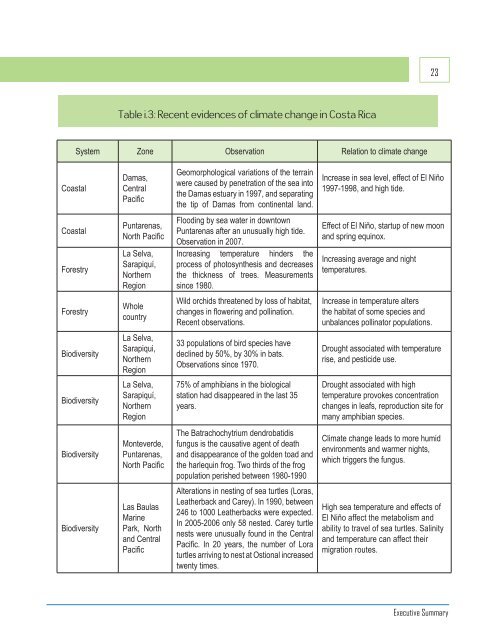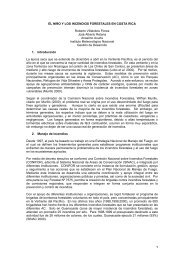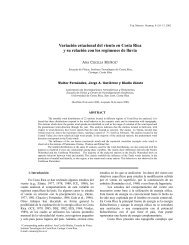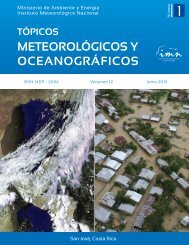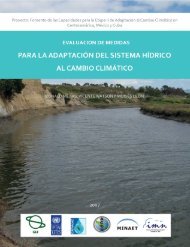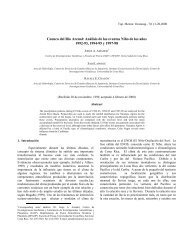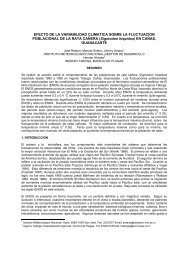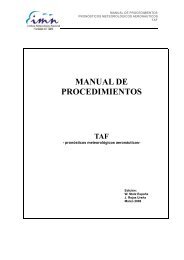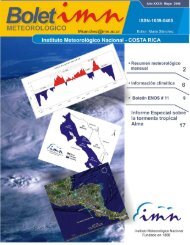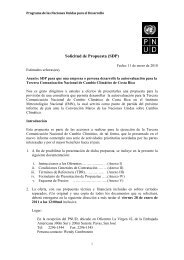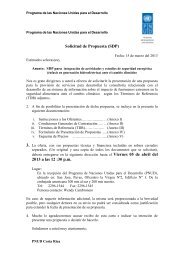descargar Documento - IMN - Instituto Meteorológico Nacional
descargar Documento - IMN - Instituto Meteorológico Nacional
descargar Documento - IMN - Instituto Meteorológico Nacional
You also want an ePaper? Increase the reach of your titles
YUMPU automatically turns print PDFs into web optimized ePapers that Google loves.
23<br />
Table i.3: Recent evidences of climate change in Costa Rica<br />
System Zone Observation Relation to climate change<br />
Coastal<br />
Damas,<br />
Central<br />
Pacific<br />
Geomorphological variations of the terrain<br />
were caused by penetration of the sea into<br />
the Damas estuary in 1997, and separating<br />
the tip of Damas from continental land.<br />
Increase in sea level, effect of El Niño<br />
1997-1998, and high tide.<br />
Coastal<br />
Forestry<br />
Puntarenas,<br />
North Pacific<br />
La Selva,<br />
Sarapiquí,<br />
Northern<br />
Region<br />
Flooding by sea water in downtown<br />
Puntarenas after an unusually high tide.<br />
Observation in 2007.<br />
Increasing temperature hinders the<br />
process of photosynthesis and decreases<br />
the thickness of trees. Measurements<br />
since 1980.<br />
Effect of El Niño, startup of new moon<br />
and spring equinox.<br />
Increasing average and night<br />
temperatures.<br />
Forestry<br />
Whole<br />
country<br />
Wild orchids threatened by loss of habitat,<br />
changes in flowering and pollination.<br />
Recent observations.<br />
Increase in temperature alters<br />
the habitat of some species and<br />
unbalances pollinator populations.<br />
Biodiversity<br />
La Selva,<br />
Sarapiqui,<br />
Northern<br />
Region<br />
33 populations of bird species have<br />
declined by 50%, by 30% in bats.<br />
Observations since 1970.<br />
Drought associated with temperature<br />
rise, and pesticide use.<br />
Biodiversity<br />
La Selva,<br />
Sarapiquí,<br />
Northern<br />
Region<br />
75% of amphibians in the biological<br />
station had disappeared in the last 35<br />
years.<br />
Drought associated with high<br />
temperature provokes concentration<br />
changes in leafs, reproduction site for<br />
many amphibian species.<br />
Biodiversity<br />
Monteverde,<br />
Puntarenas,<br />
North Pacific<br />
The Batrachochytrium dendrobatidis<br />
fungus is the causative agent of death<br />
and disappearance of the golden toad and<br />
the harlequin frog. Two thirds of the frog<br />
population perished between 1980-1990<br />
Climate change leads to more humid<br />
environments and warmer nights,<br />
which triggers the fungus.<br />
Biodiversity<br />
Las Baulas<br />
Marine<br />
Park, North<br />
and Central<br />
Pacific<br />
Alterations in nesting of sea turtles (Loras,<br />
Leatherback and Carey). In 1990, between<br />
246 to 1000 Leatherbacks were expected.<br />
In 2005-2006 only 58 nested. Carey turtle<br />
nests were unusually found in the Central<br />
Pacific. In 20 years, the number of Lora<br />
turtles arriving to nest at Ostional increased<br />
twenty times.<br />
High sea temperature and effects of<br />
El Niño affect the metabolism and<br />
ability to travel of sea turtles. Salinity<br />
and temperature can affect their<br />
migration routes.<br />
Executive Summary


